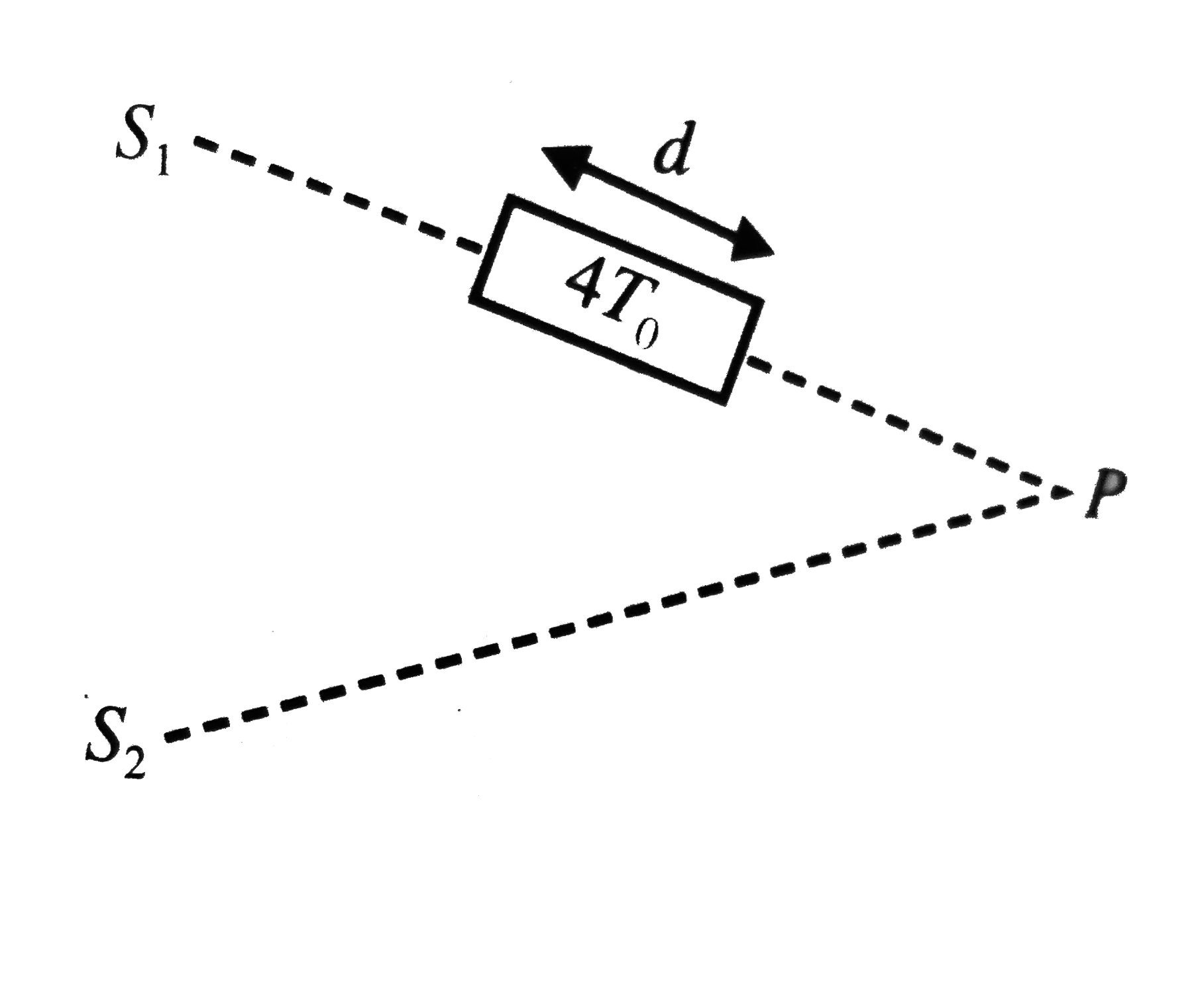Sound from coherent sources S1andS2 are sent in phase and detected at point P equidistant from both the sources . Speed of sound in normal air in V0, but in some part in path S1 , there is a zone of hot air having temperature 4× , the normal temperature , and width d. What should be minimum frequency of sound , so that minima can be found at P?

The correct Answer is:fmax=Vd
Path differnce =(μ−1)d
μ=V0V'=√γR(T0)m0√γR(4T0)m0=12
(i) |pathd⇔ernce|=∣∣∣(12−1)d∣∣∣=d2
For minima , path difference =(2n+1)λ2=d2
d(2n+1)=λ=Vf
f=V(2n+1)d
fmin=Vd
Topper's Solved these Questions
- SUPERPOSITION AND STANDING WAVESBOOK - CENGAGE PHYSICSCHAPTER - SUPERPOSITION AND STANDING WAVESEXERCISE - Single Correct
144 Videos
- SUPERPOSITION AND STANDING WAVESBOOK - CENGAGE PHYSICSCHAPTER - SUPERPOSITION AND STANDING WAVESEXERCISE - Multiple
26 Videos
- SUPERPOSITION AND STANDING WAVESBOOK - CENGAGE PHYSICSCHAPTER - SUPERPOSITION AND STANDING WAVESEXERCISE - Exercise 7.2
32 Videos
- SOUND WAVES AND DOPPLER EFFECTBOOK - CENGAGE PHYSICSCHAPTER - SOUND WAVES AND DOPPLER EFFECTEXERCISE - Integer
16 Videos
- THERMODYNAMICSBOOK - CENGAGE PHYSICSCHAPTER - THERMODYNAMICSEXERCISE - 24
1 Videos
Similar Questions
Speed of sound in air is 330m/s.Find maximum and minimum wavelength of audible sound in air.
View SolutionA source of sound of frequency n is moving towards a stationary observer with a speed S. If the speed of sound in air is V and the frequency heard by the observer is n1 ,the value of n1/n is
View Solution
Knowledge Check
The speed of sound in air at NTP is 332 m/s. If air pressure becomes four times the normal then the speed of sound waves will :
ADoubleBQuadrupleCRemain the sameDbecome 14 of the original valueTwo sources S1andS2 of sound having frequencies 338, 342 Hz are separated by a large distance. The speed of sound is 340 m/s. The velocity of the observer who is moving from S2 to S1 so that he does not hear any beats is
A1 m/sB2 m/sC3 m/sD4 m/sStatement-1: The quality of sound in independent of the listerner's distance from the source of sound
Statement-2: The speed of sound in air is independent of the frequency of sound waves.AStatement-1 is true, statement-2 is true, statement-2 is a correct explanation for statement-1BStatement-1 is true, statement-2 is true, statement-2 is not a correct explanation for statement-1Cstatement-1 is true, statement-2 is falseDstatement-1 is false, statement-2 is true
Two identical sources of sound S1andS2 produce intensity I0 at a point P equidistant from each source .
(i) Determine the intensity of each at the point P.
(ii) If the power of S1 is reduced to 64% and phase difference between the two sources is varied continuously , then determine the maximum and minimum intensities at the point P.
(iii) If the power of S1 is reduced by 64% , then determine the maximum and minimum intensities at the point P.
View SolutionThree sources of sound S1,S2andS3ofequal∫ensityareplaced∈astraightl∈ewithS_1S_2=S_2=S_3.Atap∮P.farawayomthesources,thewavecomingomS_2 si 120^@ahead∈phaseoftˆomS_1.Also,thewavecomingomS_3 is 120^@aheadoftˆomS_2. What would be the resultant intensity of sound at P?

View SolutionIn Quincke's experiment the sound detected is changed from a maximum to a minimum when the sliding tube is moved through a distance of 2.50 cm. Find the frequency of sound if the speed of sound in air is 340ms−1.
View SolutionThe speed of sound in air at S.T.P is 3000m/s .If the air pressure becomes double ,the temperature remaining the same ,the speed of sound would
View SolutionThe speed of sound in air at NTP is 332 m s−1. If air pressure becomes four times the normal, then the speed of sound will
View Solution
